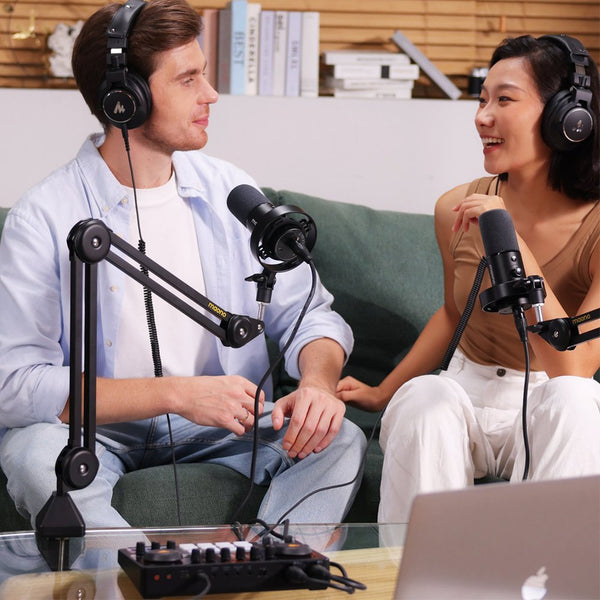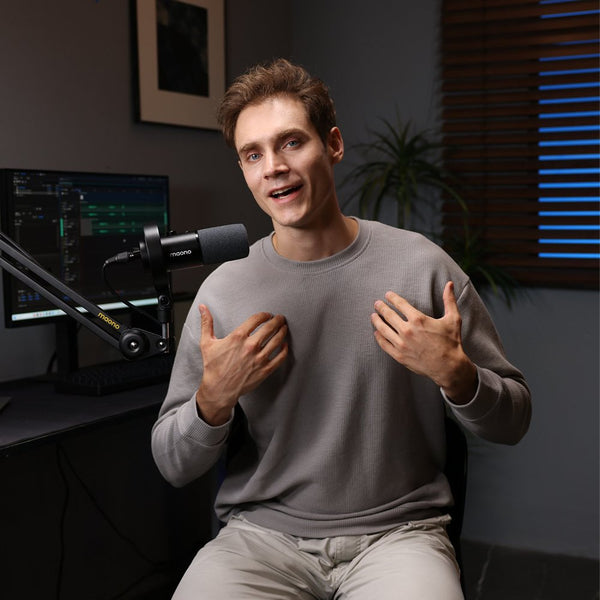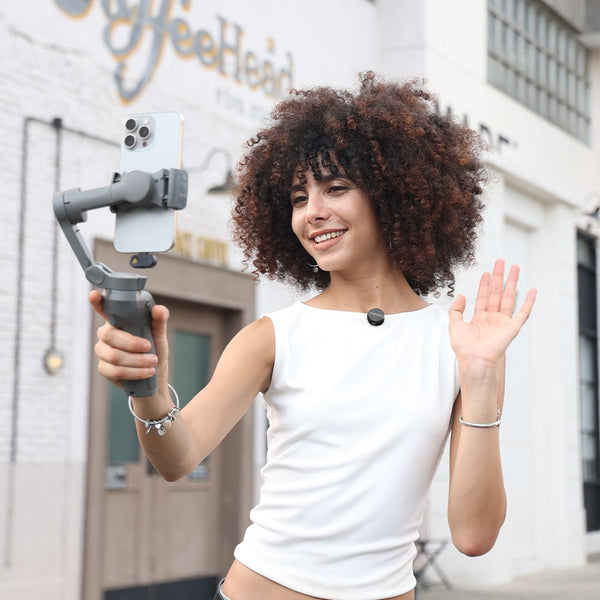Facebook Live is a great platform for discussing relevant topics—whether in the form of an interview, a solo broadcast, expert advice, podcast content, and so forth—you name it. However, to catch the attention of your target audience, you need to deliver a message that is clear, not muffled or echoing. It needs to sound professional in order to build trust. In this article, we will recommend a streaming microphone to help you achieve that.
Facebook Live has become an essential tool for content creators, podcasters, educators, and entrepreneurs to connect with audiences in real time. One of the most engaging formats on Facebook Live is the guest interview, where you invite a subject-matter expert, influencer, or co-host to join your broadcast. When done right, these interviews can boost your authority, increase audience retention, and expand your reach. Also, success hinges on preparation—especially when it comes to microphone setup and audio clarity.
In this guide, we’ll explore the top tips for interviewing a guest on Facebook Live, including how to integrate a remote guest, tools to manage the stream, and why choosing the right streaming microphone—like a cardioid mic such as the Maono PD200X—is key to a professional sound.
How to Prepare for a Guest Interview on Facebook Live
The foundation of a successful Facebook Live guest interview lies in preparation. Here's a checklist to get started:
-
Schedule your stream in advance and promote it on your page, group, or event.
-
Confirm your guest’s tech setup—microphone, webcam, internet connection.
-
Choose a streaming platform that allows easy guest integration (more on that below).
-
Test your audio, lighting, and internet beforehand.
-
Draft a brief interview outline or key talking points to guide the flow.
Even if you're an experienced live streamer, technical hiccups are common. But with the right mic setup and streaming tools, you can significantly reduce the risk of poor audio and create a smoother experience for both the guest and audience.
Even if you're an experienced live streamer, technical hiccups are common. But with the right stream microphone setup and streaming tools, you can significantly reduce the risk of poor audio and create a smoother experience for both the guest and the audience.
What’s the Difference Between Cardioid and Omnidirectional Mics?
One of the first questions you might ask when choosing a podcast microphone or streaming microphone is: What type of mic should I use for a live interview?
-
Cardioid Microphones
These mics capture sound directly in front of them while rejecting noise from the sides and rear. Ideal for focused speech in live interviews, they help isolate your voice from background noise.
-
Omnidirectional Microphones
These pick up sound from all directions. While useful in controlled environments or for capturing group discussions, they tend to capture more ambient noise and are not ideal for solo or two-person interviews.
Pro tip: Always go for a cardioid microphone like the Maono PD200X when conducting live interviews on Facebook. It’s specifically designed to deliver clarity and minimize distractions in real-time broadcasts.
On Guest Integration
How Do I Bring in a Remote Guest for a Facebook Live Interview?
Facebook Live doesn’t natively support built-in split-screen guest interviews unless you use a third-party tool. To bring in a remote guest:
-
Use third-party live streaming tools like StreamYard, Restream, or Zoom via OBS.
-
Share a secure guest link with your interviewee.
-
Use wired internet when possible for a more stable connection.
-
Make sure both parties are using external mics and headphones to avoid echo.
What Platforms and Tools Can I Use to Stream a Guest Speaker to Facebook?
Popular tools for streaming guest interviews to Facebook Live include:
-
StreamYard: Browser-based and user-friendly. Lets you invite guests, manage layouts, and go live directly to Facebook.
-
OBS Studio (Open Broadcaster Software): Free and powerful but has a steeper learning curve. Use it with tools like Zoom, Skype, or vMix for guest integration.
-
Restream: Allows multistreaming and easy guest invites with high audio-video quality.
-
BeLive or Ecamm Live (Mac only): Great for solo creators who want branding, screen sharing, and easy guest setup.
Can I Use OBS or StreamYard to Manage Audio Quality With My Guest?
Yes. These tools allow you to:
-
Adjust guest microphone gain levels.
-
Add noise suppression filters in OBS.
-
Use audio compression and EQ to smooth out volume differences.
-
Monitor guest sound live using headphones.
Both platforms give you flexibility to make real-time audio adjustments, especially if you're using external audio gear like mixers or audio interfaces.
How Do I Balance the Guest’s Mic Volume With Mine During a Live Stream?
To ensure audio consistency:
-
Use audio monitoring features in OBS or your interface.
-
Test mic levels during a pre-call. Adjust gain if needed.
-
Avoid using auto-gain settings; they can cause unexpected volume shifts.
-
Consider using an audio interface or mixer to fine-tune audio manually.
FAQs About Microphone Setup:
Can I Use Two USB Microphones Simultaneously for a Guest Interview?
On one computer, using two USB microphones simultaneously is tricky. Most operating systems won’t support dual USB mic input natively. Workarounds include:
-
Using a digital audio interface with XLR mics.
-
Creating an Aggregate Device (Mac) or using software like Voicemeeter (Windows).
How Do I Avoid Echo or Feedback When Both Me and the Guest Are Using Mics?
-
Both you and your guest should wear headphones to prevent speaker audio from re-entering the mic.
-
Enable echo cancellation if available in your streaming platform.
-
Use directional (cardioid) mics and position them properly.
Do I Need an Audio Interface for Dual-Microphone Facebook Live Interviews?
If you’re using XLR microphones, yes—you’ll need an audio interface to connect both mics and manage their inputs. For USB setups, it depends:
-
Single host setup: A USB mic is fine.
-
Two in-person guests: Better to use an audio interface with two XLR mics.

Should I Use a Pop Filter or Windscreen for Facebook Live Interviews?
Yes. A pop filter or foam windscreen helps reduce plosive sounds like "P" and "B", which can distort your voice. It also:
-
Adds a layer of professionalism to your sound.
-
Prevents saliva from hitting the mic capsule.
Should I Use Headphones While Interviewing a Guest Live to Avoid Feedback?
Absolutely. Using closed-back headphones helps you:
-
Monitor your audio levels.
-
Avoid echo and feedback.
-
Hear your guest clearly without bleed into your mic.
What Type of Streaming Microphone Is Best for Interviewing a Guest on Facebook Live?
The best choice for interviews is a cardioid dynamic microphone. Cardioid mics focus on sound coming from the front, reducing background noise and echo—perfect for indoor live streams. Two standout options are the Maono PD200X and Maono PD300X.
The ideal streaming microphone should offer:
-
Cardioid pickup pattern (to focus on your voice).
-
USB/XLR hybrid connectivity (for flexibility).
-
Clear frequency response suited to voice.
A perfect example is the Maono PD200X.

What’s Great About the Maono PD200X?
The Maono PD200X is a dynamic cardioid microphone specifically designed for streamers, podcasters, and live content creators. Here's why it’s one of the best budget microphones for streaming and podcasting.
-
Cardioid Pattern
Rejects background noise, captures your voice clearly.
-
USB and XLR Outputs
Use it as a plug-and-play mic or pair with an audio interface.
-
Built-In Headphone Jack
Real-time monitoring without latency.
-
Tunable Gain Control and ‘One-click’ Mute Button
Manage levels on the fly during the stream.
-
Sleek Design With RGB Lighting
Adds visual appeal for video podcasts or Lives.
Whether you're hosting your first live stream or expanding your podcast, the PD200X provides a professional-quality experience at an affordable price—making it an excellent podcast microphone and streaming microphone.
What’s Great About the Maono PD300X?

Maono PD300X – Tailored for podcasting and live streaming, this USB mic has an integrated shock mount and digital gain knob. The PD300X uses a cardioid pickup pattern to isolate your voice, making it ideal for solo interviews or indoor environments with some ambient noise.
Features:
-
Plug-and-play USB/XLR connectivity
-
Studio-quality sound
-
Cardioid pickup for noise reduction
-
Zero-latency monitoring
Both models are excellent for streamers and interview hosts who want easy setup, reliable performance, and clear vocal delivery.
How Do I Promote a Facebook Live Interview Ahead of Time?
Promotion is key to a successful stream. Try these strategies:
-
Create a Facebook Event and invite your audience.
-
Tease the topic and guest in advance via short video clips or stories.
-
Share behind-the-scenes photos of your stream microphone setup.
-
Collaborate with your guest for cross-promotion on their channels.
-
Send a reminder email to your mailing list with the date, time, and link.
Can I Repurpose the Audio From a Facebook Live Interview Into a Podcast Episode?
Yes, and you absolutely should. Repurposing allows you to:
-
Expand your audience across platforms.
-
Boost your SEO through multiple content formats.
-
Save time by using existing content.
To do this:
-
Download the video recording after the live ends.
-
Extract the audio using software like Audacity or Adobe Premiere.
-
Clean up the audio (remove noise, adjust levels).
-
Add an intro/outro and publish to your podcast host.
Conclusion
Facebook Live interviews can boost your visibility, authority, and engagement—if done right. From selecting the proper microphone to managing your guest’s audio feed, each element contributes to the quality of your broadcast.
For the best results, choose a cardioid dynamic mic like the Maono PD200X or PD300X to ensure professional-grade audio. Combine that with reliable streaming software, thoughtful promotion, and smart audio practices like wearing headphones and using pop filters—and your live interviews will sound as good as they look.
Whether you're hosting a business expert, influencer, or friend with a great story, great audio is non-negotiable. Set yourself apart with the right gear and preparation—and your audience will keep coming back for more.



